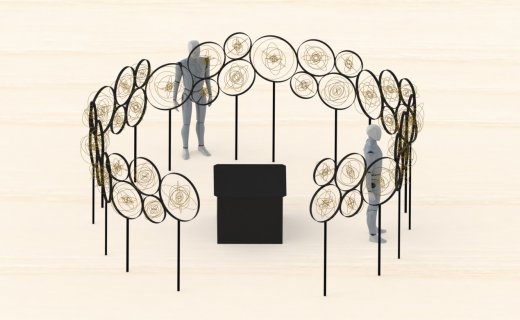Hey everyone,
I'm looking for some input on my Burning Man project -- Ring Theory.

From an architecture standpoint, the installation is organized into 8 panels. Each has a pixel count of about 500. Three 50W 12V-5V buck converters provide power per panel.
Here is a more detailed breakdown of pixel counts:
Total project: 8 panels
Each panel: ~500 pixels (not over 512)
One panel contains: Whole project contains:
2x 77 pixel strings 16x 77 pixel strings
2x 106 pixel strings 16x 106 pixel strings
1x 135 pixel string 8x 135 pixel string
After initially looking at FadeCandy (and realizing it is not compatible with the strip lengths above), I am looking for recommendations on how to approach this. I have so far observed the following options:
1. Use one Teensy 3.2 & OctoLED adapter to drive 4000 pixels, maybe integrate an SD card for added memory. Each panel would be treated as a single 500 pixel string. The drawback here is that, due to physical layout, data lines could get long (7-10ft) causing issues. This brings me to option 2:
2. Use eight Teensy 3.2s & OctoLED boards, put one teensy on each panel, and use a embedded PC (hopefully Rasberry Pi?) to control all of them via USB bus. I imagine USB will be more robust over a 7-10ft data line, and this would allow me to use a pin for each pixel string above. This will be more expensive, however, and considering this is my first major LED project maybe I'll be biting off more than I can chew. Option 3:
3. Similar to #2, but use Teensy LCs with USB Hub to minimize costs, as putting a Teensy 3.2 on each panel would be overkill. Use Rasberry Pi and USB hub to drive. I recognize that the LC is a bit more limited, but don't fully understand the implications for this project. If it seems suited to the task, it would be the lower-cost option!
Although I have a engineering background, LED projects of this scope are new to me. I'm really hoping someone out there can set me down the right path so I can deliver the best possible product! If there is another good solution out there, let me know! Thanks guys!
JohnnyP
I'm looking for some input on my Burning Man project -- Ring Theory.

From an architecture standpoint, the installation is organized into 8 panels. Each has a pixel count of about 500. Three 50W 12V-5V buck converters provide power per panel.
Here is a more detailed breakdown of pixel counts:
Total project: 8 panels
Each panel: ~500 pixels (not over 512)
One panel contains: Whole project contains:
2x 77 pixel strings 16x 77 pixel strings
2x 106 pixel strings 16x 106 pixel strings
1x 135 pixel string 8x 135 pixel string
After initially looking at FadeCandy (and realizing it is not compatible with the strip lengths above), I am looking for recommendations on how to approach this. I have so far observed the following options:
1. Use one Teensy 3.2 & OctoLED adapter to drive 4000 pixels, maybe integrate an SD card for added memory. Each panel would be treated as a single 500 pixel string. The drawback here is that, due to physical layout, data lines could get long (7-10ft) causing issues. This brings me to option 2:
2. Use eight Teensy 3.2s & OctoLED boards, put one teensy on each panel, and use a embedded PC (hopefully Rasberry Pi?) to control all of them via USB bus. I imagine USB will be more robust over a 7-10ft data line, and this would allow me to use a pin for each pixel string above. This will be more expensive, however, and considering this is my first major LED project maybe I'll be biting off more than I can chew. Option 3:
3. Similar to #2, but use Teensy LCs with USB Hub to minimize costs, as putting a Teensy 3.2 on each panel would be overkill. Use Rasberry Pi and USB hub to drive. I recognize that the LC is a bit more limited, but don't fully understand the implications for this project. If it seems suited to the task, it would be the lower-cost option!
Although I have a engineering background, LED projects of this scope are new to me. I'm really hoping someone out there can set me down the right path so I can deliver the best possible product! If there is another good solution out there, let me know! Thanks guys!
JohnnyP

